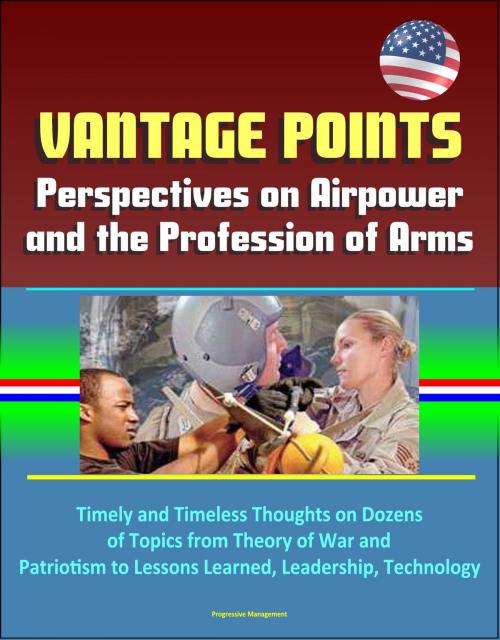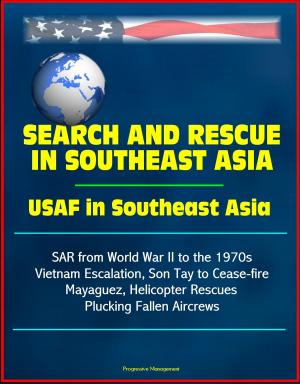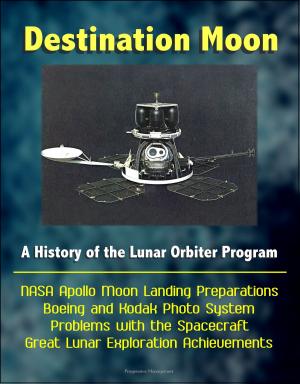Vantage Points: Perspectives on Airpower and the Profession of Arms - Timely and Timeless Thoughts on Dozens of Topics from Theory of War and Patriotism to Lessons Learned, Leadership, Technology
Nonfiction, History, Military, Aviation, United States| Author: | Progressive Management | ISBN: | 9781370689514 |
| Publisher: | Progressive Management | Publication: | September 2, 2016 |
| Imprint: | Smashwords Edition | Language: | English |
| Author: | Progressive Management |
| ISBN: | 9781370689514 |
| Publisher: | Progressive Management |
| Publication: | September 2, 2016 |
| Imprint: | Smashwords Edition |
| Language: | English |
This excellent report has been professionally converted for accurate flowing-text e-book format reproduction. There is no finer learning organization than the United States Air Force. At the tactical level, aircrews thoroughly debrief every sortie, supervisors carefully brief their shifts, and units maintain meticulous records. The Air Force uses precision instrumentation to record every test and debrief every Red Flag mission—these and other measures ensure the integrity of what we learn. We collect what we've learned in databases, lessons learned, tactics manuals, histories, and professional journals—we accumulate useful knowledge so we can serve more effectively. Whether newly enlisted or general officers, we continue to learn every day—we master what's important to attain professional excellence.
As we enter Air Force service, our primary learning goal is to become experts in our field. That's the first step toward leadership. As we master our individual duties, we gain insight into the broader organization. By the time an air traffic controller is qualified, he or she has learned about weather, radios and radar, airfield engineering, navigational aids, aircraft operations, and many other fields. The wider our professional grasp, the better our decisions. Thousands of years before any aircraft flew, profound masters of the profession of arms encouraged learning. We inherit a practical focus from those soldiers, sailors, and statesmen: study successes and failures to understand what works.
Airmen have added tremendously to this severe school of study. The third dimension adds unprecedented vision, speed, range, and freedom of action. The application of air and space power in concert with other arms created joint operations, a distinctive advantage of American arms. Airmen also contribute a unique perception of time, a penchant for maximizing the effects of scarce resources on a theater scale, and a habit of looking ahead - "lead-turning events." This book presents both timely and timeless thoughts on our profession. It pairs them with images of Airmen who embody those thoughts and prove them in action. It is a reminder that professional growth is something we owe to other Airmen and our nation. We treasure the lessons we've learned because so many have been paid for in blood. In turn, we apply them—to fly, fight, and win—don't you ever forget it!
Theory of War * Patriotism * Air, Space, and Cyber Power * Doctrine * Education, Training, and Lessons Learned * Preparedness, Security, and Force Protection * Planning * Leadership and Professionalism * Character and Leadership Traits * Technology * Logistics * Intelligence, Surveillance, and Reconnaissance * Unmanned Aerial Vehicles * Information and Communications * Joint Perspectives * Coalition Operations * Airpower at War * Irregular Warfare / Counterinsurgency
This excellent report has been professionally converted for accurate flowing-text e-book format reproduction. There is no finer learning organization than the United States Air Force. At the tactical level, aircrews thoroughly debrief every sortie, supervisors carefully brief their shifts, and units maintain meticulous records. The Air Force uses precision instrumentation to record every test and debrief every Red Flag mission—these and other measures ensure the integrity of what we learn. We collect what we've learned in databases, lessons learned, tactics manuals, histories, and professional journals—we accumulate useful knowledge so we can serve more effectively. Whether newly enlisted or general officers, we continue to learn every day—we master what's important to attain professional excellence.
As we enter Air Force service, our primary learning goal is to become experts in our field. That's the first step toward leadership. As we master our individual duties, we gain insight into the broader organization. By the time an air traffic controller is qualified, he or she has learned about weather, radios and radar, airfield engineering, navigational aids, aircraft operations, and many other fields. The wider our professional grasp, the better our decisions. Thousands of years before any aircraft flew, profound masters of the profession of arms encouraged learning. We inherit a practical focus from those soldiers, sailors, and statesmen: study successes and failures to understand what works.
Airmen have added tremendously to this severe school of study. The third dimension adds unprecedented vision, speed, range, and freedom of action. The application of air and space power in concert with other arms created joint operations, a distinctive advantage of American arms. Airmen also contribute a unique perception of time, a penchant for maximizing the effects of scarce resources on a theater scale, and a habit of looking ahead - "lead-turning events." This book presents both timely and timeless thoughts on our profession. It pairs them with images of Airmen who embody those thoughts and prove them in action. It is a reminder that professional growth is something we owe to other Airmen and our nation. We treasure the lessons we've learned because so many have been paid for in blood. In turn, we apply them—to fly, fight, and win—don't you ever forget it!
Theory of War * Patriotism * Air, Space, and Cyber Power * Doctrine * Education, Training, and Lessons Learned * Preparedness, Security, and Force Protection * Planning * Leadership and Professionalism * Character and Leadership Traits * Technology * Logistics * Intelligence, Surveillance, and Reconnaissance * Unmanned Aerial Vehicles * Information and Communications * Joint Perspectives * Coalition Operations * Airpower at War * Irregular Warfare / Counterinsurgency















